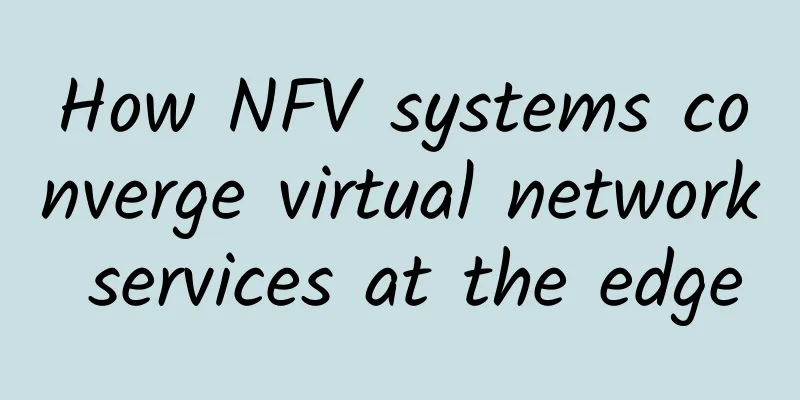How NFV systems converge virtual network services at the edge

|
Think back to the days before smartphones, when people would carry around a variety of electronic devices, such as flip phones, digital cameras, MP3 players, fitness trackers, Nintendo game consoles, and more. Whenever you go out, you probably need a backpack to carry these electronic products. However, after modern technology has integrated all these functions into smartphones, some electronic products that once had a market size of billions of dollars have been ruthlessly eliminated. And 10 years ago, the same thing happened in the network industry, thanks to NFV systems.
Functionality once delivered through discrete hardware is now encapsulated in software applications running as virtual appliances on servers, and server virtualization and containerization are the foundation of today’s enterprise software stack. What virtualization does for business applications is deliver network services in the form of NFV and virtual or universal customer premise equipment (known as vCPE and uCPE, respectively). The rationale for using servers to run multiple network services is similar to the rationale for incorporating digital cameras, media players, and GPS devices into cell phones: it provides greater flexibility, convenience, performance, and manageability at lower costs by leveraging economies of scale and new technologies. Unlike smartphones’ low-power systems-on-chip (SoCs), imaging chips, and touchscreen displays, NFV systems and infrastructure leverage increasingly powerful server processors, switch chips, and solid-state storage devices, enabling the cabinet to accommodate more network applications and user sessions. Software-defined networking (SDN) and functions benefit both operators and enterprises. Operators were the first to realize the benefits of NFV and have implemented most of the early NFV deployments. However, as enterprises redesign their networks using software-defined WAN (SD-WAN) to provide lower-cost, high-performance connections to branch offices, warehouses, and temporary workspaces, they are rediscovering the advantages of distributed infrastructure (edge computing). These two trends, network function virtualization and edge computing, are now beginning to converge as edge infrastructure has emerged as a way to combine SD-WAN endpoints and other network services on a single piece of hardware. Fast-growing market Like most nascent trends, NFV edge hardware has no fixed or widely accepted boundaries. The imprecision of its semantics leads to different estimates of market size and growth rate. However, most network observers agree that its sales are rising rapidly. The edge virtual networking market consists of three categories:
A fundamental element of a network function virtualization setup, where virtual network functions (VNFs) are the building blocks within the NFV framework. Together, these components provide a virtual implementation of network services, and their growth is exploding. Network Function Virtualization is on the rise Here is a look at the market developments for the components that make virtualized network services possible:
Granted, such high growth rates are typical of emerging markets built from scratch. However, there are several factors that will drive NFV, vCPE, and uCPE sales to multi-billion dollar proportions. These include:
Features and use cases In addition to the cost benefits of using commodity components, the main benefit of a converged virtual network infrastructure is the flexibility to run multiple services on a single piece of hardware. The software-based design also makes it possible to combine multiple VNFs into so-called service chains, allowing the SD-WAN endpoint to terminate at an IP voice session border controller or firewall. The most popular VNFs for enterprises of all sizes include:
NFV System Products The focus of NFV and vCPE is to decouple network hardware from software to provide the flexibility to use any processor architecture and system design capable of running a virtualization or container stack. This adaptability makes it impossible to compile an exhaustive list of NFV products, as any computer can run virtual network services, whether it is a 4U and 4S with more than TB of memory or a Raspberry Pi using an Arm SoC with DDR memory. Nevertheless, system vendors have responded to the growing interest in converged virtual services by releasing products targeted at network edge environments. The following are the mainstream products currently available: (1) The Cisco CSP 5000 Series includes 1U and 2U 2S systems based on UCS C220 and C240 servers and a version of Red Hat Enterprise Linux customized for NFV applications. The Cisco CSP 5000 system supports a variety of Cisco VNFs, including:
(2) Nexus 1000V Virtual Security Gateway and Virtual Hypervisor Module The Cisco ENCS 5000 is a hybrid computing router platform for enterprise edge deployments. ENCS integrates Cisco's virtual integrated services router, integrated SD-WAN software, vWAAS, ASAv and virtual wireless LAN controller, as well as support for the vendor's NFV infrastructure software platform.
Why are enterprises interested in edge NFVI? Enterprise interest in edge servers using NFVI is driven by four factors:
Together, these factors provide enterprises with the flexibility to consolidate network services and enterprise applications on the same NFV system and hardware, which can improve the performance, efficiency and scalability of remote infrastructure compared to traditional dedicated network hardware. |
<<: Review of 5G industry-specific networks in 2020: The beginning of a new era
>>: Let's talk about the time-consuming TCP connection
Recommend
Zheye IO year-end promotion: 30% off all cloud servers + free memory, 200 yuan off for independent servers, 300 yuan free for 1,000 yuan recharge
ZheyeIO has released a 2020 year-end promotion pl...
Universal crawler techniques: How to properly remove invalid parameters from URLs
We know that a URL consists of the following part...
In which industries can blockchain be applied?
In recent years, blockchain technology has become...
Security advantages and challenges of HTTP3 protocol
HTTP/3 is the third official version of the Hyper...
You must know the five common misconceptions about HTTPS
Nowadays, the https protocol is widely valued and...
Do you know the misunderstandings about 5G?
Today I will reveal to you five misunderstandings...
VMISS 30% off: Los Angeles/Japan/Hong Kong VPS monthly payment starts from 3.5 Canadian dollars (≈ RMB 18 yuan)
VMISS is a new merchant founded in Canada. It cur...
DediPath New Year Offer: 50% off all VPS hosts, 1Gbps unlimited dedicated server in Los Angeles starting from $39/month
DediPath is a foreign service provider founded in...
Master these 5 tips to deploy Wi-Fi 6 to achieve the best results
The Wi-Fi 6 standard (802.11ax) brings many excit...
CrownCloud: Los Angeles 1TB large hard drive VPS annual payment starts at $30, AMD Ryzen7950X series annual payment starts at $35
CrownCloud, which I first shared information abou...
5G: The era of “oligopoly” operators ends, and the era of cross-border “group fights” begins
If you establish a mapping relationship between I...
Wi-Fi 7 is already here before Wi-Fi 6 is used?
On April 19, although Wi-Fi 6 is being widely pop...
Great news: Global IPv6 usage rate hits a new high, and my country's IPv6 will be fully popularized
According to Google user statistics, as of June t...
LOCVPS launches 1Gbps port VPS in Hong Kong, 20% discount, monthly payment starts from 36 yuan
LOCVPS launched a 1Gbps port Hong Kong VPS host b...









